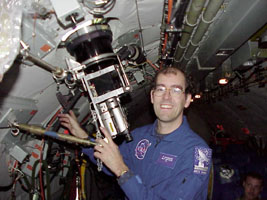|
Leonid MAC |
| home |
| View the shower |
| Mission Brief |
| Science Update |
| Media Brief |
| links |
 Peter Jenniskens,
Peter Jenniskens,
SETI Institute, at NASA/Ames Research Center
Last updated: February 2007
Brief Biographical Information: Meteor astronomer. Principal Investigator of Leonid MAC. Research Scientist with the SETI Institute, stationed at NASA/Ames Research Center. Dr. Jenniskens coordinates the various experiments on Leonid MAC in order to achieve highest synergy.
Research Interests (Publications):

Dr. Jenniskens with his slit-less meteor spectrograph "BETSY"
Research on Leonid MAC: High resolution optical spectroscopy of meteors and trains, and meteor imaging for studies of meteor stream dynamics. Jenniskens studies the fate of organic matter in meteoric ablation, with support of NASA's Exobiology program. He contributes optical spectrometers to the mission, in order to measure the presence of organic matter in meteors and the physical conditions that determine if the organic matter can survive the ablation process. This work has lead to a new meteor model that shows potential gentle pathways for organic matter survival and just the right conditions for interesting atmospheric chemistry. A special issue of the journal Astrobiology presented results from the 2001 and 2002 Leonid MAC missions: studies of the plasma temperature and temperature decay in the wake of meteors and studies of CN, OH, and H emission that probe the exogenous delivery of organics and water.
Meteor spectrum Dr. Jenniskens also contributes to the mission a large number of intensified video cameras to document the shower activity. Those records are used:
|


 Author of "Meteor Showers and their Parent Comets" (2006, Cambridge University press, 790 pp.)
Author of "Meteor Showers and their Parent Comets" (2006, Cambridge University press, 790 pp.)

